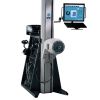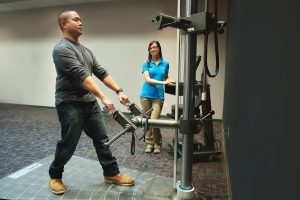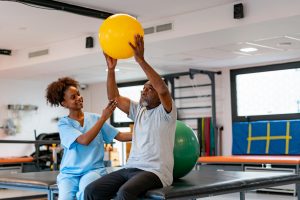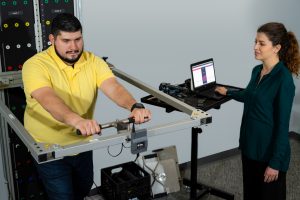
Task Simulation Tools for Occupational Rehab
Treatment GuidelinesWith specialized task simulation tools, occupational rehab clinics can recreate realistic work environments, making the transition back to the job smoother. This involves accurately matching the weight and handle of objects, meeting endurance and repetition requirements, and simulating lifting heights.
Task simulation tools are essential in occupational rehabilitation, enabling clinicians to accurately replicate job tasks for injured workers. The primary objective of occupational rehabilitation is to ensure a safe return to work. While all physical therapists and occupational therapists aim to restore functional ability, those in occupational rehab adopt a specifically job-focused approach. Occupational rehab focuses on job-specific tasks to meet the demands of the patient’s workplace.
In this article, we’ll explore how task simulation tools help occupational rehab therapists enhance their treatment sessions. Specifically, we’ll look at grip styles, power tool simulation, repetitive lifting, and bending tasks. These job tasks apply to various roles, from construction workers and mechanics to childcare providers and office workers.
What is Occupational Rehab?
Occupational rehabilitation, also known as worker rehab, is a specialized field of physical therapy and occupational therapy. PTs and OTs working in occupational rehab will focus almost exclusively on job-specific tasks for patients. These clinicians will use task simulation tools to progressively ease the patient back into their work routine. While home tasks and ADLs may occasionally be addressed, the primary focus remains on job-related tasks.
Typical patient scenarios in occupational rehab include the following:
- Active worker’s compensation claims
- Pre-hire evaluations
- Functional capacity evaluations (FCE)
- Work hardening
In short, occupational rehab helps anyone in a situation where their current limitations are hindering their job performance.
Importance of Task Simulation Tools in Occupational Rehab
All jobs, even those that are considered sedentary, pose the risk for injury. An office worker with carpal tunnel and a warehouse worker with lower back pain both need to address their injuries so they can safely continue their job.
For this reason, task simulation tools for occupational rehab must be precise. Replicating job tasks in the clinic helps injured workers prepare for the physical demands of their roles. This involves accurately matching the weight and handle of objects, meeting endurance and repetition requirements, and simulating lifting heights necessary for their tasks. Precision in these simulations is crucial because it helps workers rebuild strength and functionality and boosts their confidence in performing the duties safely and without re-injury. Using specialized task simulation tools, occupational rehab clinics can recreate realistic work environments, making the transition back to the job smoother.
As with any rehabilitation scenario, plans of care should advance progressively. You may start with simple exercises, and work toward the patient performing the exact tasks from the job. Up next, we’ll review some common occupational rehab tasks and task simulation tools that will help you replicate them in the clinic.
How Task Simulation Tools Replicate Grip Styles
Gripping is one task that nearly every worker (and virtually every person) has in common. We all require strong, versatile gripping to navigate our daily lives. Many jobs require very specific grips in very specific positions. For instance, a mechanic using a wrench must grip the tool in a certain way and produce enough torque to use the tool. Many other physical jobs will require unique hand gripping positions as well. Matching these grip requirements in the clinic is essential for return to work for these patients.
Using a wrench for occupational rehab is a popular application of the PrimusRS. The PrimusRS allows for plenty of adjustment to finger position, wrist position, body position, activity height (including overhead), and resistance mode. This advanced occupational rehab tool offers various handles and grips that replicate job demands precisely. Common tools and grip styles for occupational rehab include:
- Standard grip at various heights and angles
- Wrench tool, overhead
- Large knob, smooth or knurled
- Small knob, smooth or knurled
- Spheres of various sizes
- Key grip

How Task Simulation Tools Replicate Power Tool Use
Power tools require a steady hand and excellent, specifically-directed strength. If one is using a drill and can’t apply enough pressure to control the tool, they may end up getting hurt. Depending on the power tool and the specific work needs of the patient, you may want to incorporate some instability work and grip strengthening in the required position.
For instance, many contractors and construction workers need to kneel while drilling. A decent starter exercise may be to have the patient perform rapid alternating contractions with an unstable weight, such as one filled with water or sand, in a kneeling position.
Likewise, those who need to use chainsaws as part of their work will need to be well-prepared when returning to the field using these dangerous tools. The heavy chainsaw needs to be controlled precisely. This can be replicated with the lifting and maneuvering of a long-handled weighted implement. This simulates the torque experienced while using a chainsaw.
Further, non-power tools, such as a sledgehammer, also bear consideration. Starting off with a hammering motion using a simple hammer, and slamming a medicine ball into the ground can both respectively help to simulate the motions and accuracy involved with sledgehammer work.
For more precise replication, PrimusRS offers a variety of power tool attachments, allowing you to simulate:
- Drill at various heights and angles (with torque control)
- Impact drill
- Jackhammer
- Concrete saw
- Hole saw push
In addition to task simulation exercises, its data-driven assessment and dosing allow the clinician to quantify and report patient’s progress. The ability to provide objective functional reports is particularly important for worker’s compensation cases and returning patients to physically demanding jobs.
How Task Simulation Tools Replicate Lifting Tasks
Many injured workers perform heavy labor all day long. Lifting bags of mulch at a garden store, stacking boxes at a warehouse; the list goes on and on. A big part of rehabbing these workers is ensuring they are moving with proper body mechanics. Even though lifting a box off of the floor and putting it on a shelf is a simple task in theory, it requires good lifting form, especially when the task is repeated all day long every day of the week.
For this, worker rehab clinicians may start by teaching the client proper deadlift form with an easy-to-grasp item, like a barbell. Once they’ve mastered the deadlift, then they should be instructed on proper form for placing the item, such as not extending their spine too far and keeping the weight close to their body while moving their feet forward instead of reaching.
From here, the task can get more specific. Lifting sandbags and heavy, unwieldy boxes with progressively higher loads will get the patient back in shape in short order. It is important to practice lifting objects that are similar in size, shape, and grip style to the patient’s actual job tasks.
Daycare centers may not be the first job that comes to mind when you think of physically demanding jobs. But caring for babies and young children is hard on the caregiver’s body. Often, they will need to bend over, kneel on the floor, get up from the floor, and hold heavy babies for long periods throughout the day. These workers can suffer wrist injuries, knee injuries, back injuries, and a host of other issues.
Replicating the tasks of a childcare worker and recommending proper equipment is a must. Proper squatting, good wrist position while holding the child, and even the use of knee pads can go a long way toward preventing and treating injuries in this population.
Using the PrimusRS, childcare workers can practice chops and lifts, key movements when setting down and lifting up a child. With the added resistance from the machine, the worker can prepare for a heavy, wiggling child that will be waiting for them when they are released back for full duty.
Conclusion
Some jobs may pose a higher injury risk than others, but this does not mean that anyone is entirely safe from a work-related injury. This is where occupational rehab specialists and the task simulation tools they have in their arsenal come into play. These specialized tools help workers remain injury-free, improve their strength and stability for the job at hand, and return to work as soon as they can.
Through the use of creative solutions and advanced machines like the PrimusRS, occupational rehab clinics can provide job-specific, progressive exercises with objective reporting, and help injured workers return to their jobs.
Bennett Richardson, PT, DPT, CSCS is a Physical Therapist and writer. He is the owner of Richardson PT LLC, a mobile, cash-based physical therapy service out of Pittsburgh, PA. Ben is passionate about many health-related topics including weight loss and athletic performance. To get in touch with Ben, visit www.richardsonpt.com





